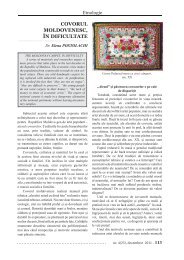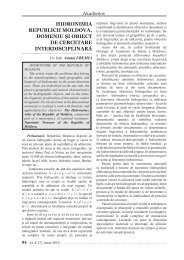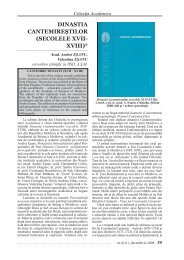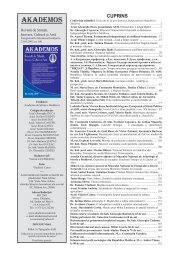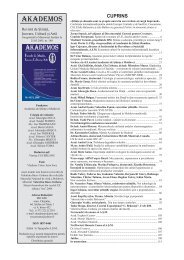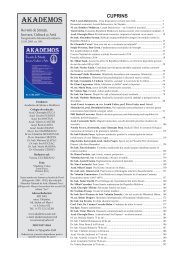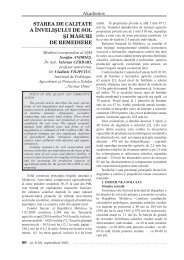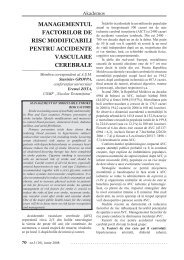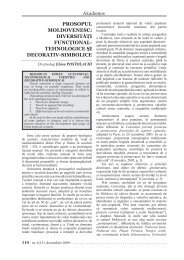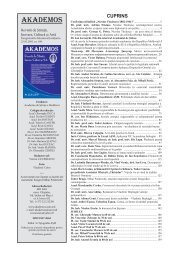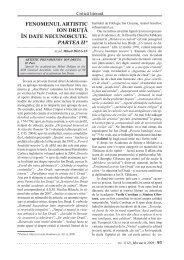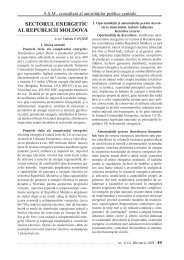Academos 4 2009.indd pentru PDF.indd - Akademos - Academia de ...
Academos 4 2009.indd pentru PDF.indd - Akademos - Academia de ...
Academos 4 2009.indd pentru PDF.indd - Akademos - Academia de ...
You also want an ePaper? Increase the reach of your titles
YUMPU automatically turns print PDFs into web optimized ePapers that Google loves.
Filologie<br />
O PROBLEMĂ A ISTORIEI<br />
LIMBII ROMÂNE<br />
APARENT REZOLVATĂ:<br />
PERIODIZAREA<br />
Klaus BOCHMANN<br />
A PROBLEM OF THE HISTORY OF<br />
ROMANIAN LANGUAGE APPARENTLY<br />
RESOLVED: PERIODIZATION<br />
The history of romanian language appears<br />
suffi ciently <strong>de</strong>scribed and the main problems<br />
resolved. However, besi<strong>de</strong> other questions (as<br />
the famous “continuity” or the presumed unity of<br />
litterary language yet in the fi rst times of written<br />
romanian) there is the problem of periodization we<br />
can still express any doubts about. The main question<br />
concerns the period of old romanian, who’s beginning<br />
is presumed for the X-th century, after the period<br />
of common romanian, and ending in the late 18-th<br />
century. Based exclusively about internal criterias of<br />
language system (phonology, morpho-syntaxis), the<br />
weakness of these periodization consists in the fact<br />
that it does not take in account the socio-cultural<br />
conditions of communication which provoked <strong>de</strong>ep<br />
changes of language as a whole: new vocabularies,<br />
new categories of texts, new manners of public<br />
discourses. In these sense it seems recommendable<br />
to presume the formation of romanian states as the<br />
end of old romanian and the beginning of a middle<br />
period, which culminated in the scripturalization of<br />
Romanian and en<strong>de</strong>d in the XVII-th century, before<br />
the period of mo<strong>de</strong>rnization of romanian culture and<br />
language.<br />
Istoria limbii române pare să fie foarte bine<br />
<strong>de</strong>scrisă, dacă luăm în ve<strong>de</strong>re bibliografia enormă<br />
<strong>de</strong> specialitate şi numele unor lingvişti dintre cei mai<br />
<strong>de</strong> seamă, care şi-au <strong>de</strong>dicat activitatea ştiinţifică<br />
acestui obiect; în această listă îi găsim pe Sextil<br />
Puşcariu, Ovid Densusianu, Alexandru Philippi<strong>de</strong>,<br />
Alexandru Rosetti, Gheorghe Ivănescu şi alţii.<br />
Să pui la îndoială unele puncte <strong>de</strong> ve<strong>de</strong>re <strong>de</strong> care<br />
ei s-au lăsat ghidaţi în cercetarea lor şi care parcă<br />
au un caracter cvasi axiomatic, poate apărea ca un<br />
sacrileg.<br />
Totuşi, când în anul 2009 am început să scriu<br />
o introducere în istoria limbii române <strong>pentru</strong> uzul<br />
stu<strong>de</strong>nţilor germani, am constatat cu mirare că<br />
există fenomene ale căror tratare mi-au produs un<br />
sentiment <strong>de</strong> nemulţumire. Menţionez în treacăt<br />
două fenomene pe care aş vrea să le pun în discuţie<br />
şi cu alte ocazii, şi anume aşa zisa problemă a<br />
continuităţii unei limbi romanice la nord <strong>de</strong> Dunăre:<br />
nedumerirea mea provine din faptul că argumentele<br />
multor lingvişti germani, care văd lucrurile cu totul<br />
altfel <strong>de</strong>cât majoritatea lingviştilor români, nu sunt<br />
discutate nicăieri sau nici măcar luate în seamă<br />
în publicaţiile româneşti. O introducere în istoria<br />
limbii române <strong>pentru</strong> stu<strong>de</strong>nţi germani însă nu<br />
poate face abstracţie <strong>de</strong> aceste puncte <strong>de</strong> ve<strong>de</strong>re, cu<br />
atât mai mult cu cât materia cu pricină va fi predată<br />
câteodată chiar <strong>de</strong> oponenţii punctului <strong>de</strong> ve<strong>de</strong>re<br />
român “oficial”. Al doilea punct critic priveşte<br />
conceptul <strong>de</strong> limba literară, în special postularea<br />
unei presupuse unităţi a ei <strong>de</strong>ja în secolele în care<br />
faptele vorbesc, după părerea mea, împotriva acestei<br />
presupuneri.<br />
Problema <strong>de</strong>spre care aş vrea să insist aici<br />
priveşte periodizarea istoriei limbii române.<br />
În istoriografia celorlalte limbi romanice, alta<br />
<strong>de</strong>cât româna, dar şi în cea germană şi engleză, se<br />
<strong>de</strong>osebeşte o fază veche – franceza veche (ancien<br />
français), spaniola veche (español antiguo), italiana<br />
veche (italiano antico), germana veche <strong>de</strong> sus şi <strong>de</strong><br />
jos (Althoch/nie<strong>de</strong>r/<strong>de</strong>utsch), engleza veche (old<br />
english) – şi una nouă sau mo<strong>de</strong>rnă, referitoare<br />
la epoca mo<strong>de</strong>rnă – franceza nouă sau mo<strong>de</strong>rnă<br />
(nouveau français, français mo<strong>de</strong>rne), germana<br />
nouă <strong>de</strong> sus şi <strong>de</strong> jos (Neuhoch/nie<strong>de</strong>r/<strong>de</strong>utsch) etc.<br />
Pentru faza actuală a limbilor se adaugă a <strong>de</strong>semna<br />
a<strong>de</strong>seori o referinţă la contemporaneitate, <strong>de</strong>ci<br />
limba franceză contemporană sau <strong>de</strong> azi (français<br />
contemporain sau d’aujourd-hui), limba germană<br />
contemporană sau <strong>de</strong> azi (<strong>de</strong>utsche Sprache <strong>de</strong>r<br />
Gegenwart / <strong>de</strong>utsche Gegenwartssprache sau<br />
heutiges Deutsch). Pentru unele limbi se presupune<br />
şi o fază mijlocie valabilă <strong>pentru</strong> epoca <strong>de</strong> tranziţie<br />
între evul mediu târziu şi epoca mo<strong>de</strong>rnă timpurie<br />
(moyen français, Mittelhoch<strong>de</strong>utsch, middle<br />
English).<br />
Ţinându-se cont <strong>de</strong> asemenea periodizări,<br />
istoriograful lingvistic poate fi tentat să le aplice<br />
şi la domeniul românesc. Sunt <strong>de</strong> părere că<br />
această viziune ar fi posibilă fără probleme dacă în<br />
istoriografia lingvistică română nu ar exista drumuri<br />
bătute care duc în alte direcţii. În lucrările <strong>de</strong><br />
referinţă este vorba <strong>de</strong>: 1. limba română primitivă<br />
sau protoromână (Urrumänisch – “străromâna”, în<br />
traducerea din 1943 în germană a operei magistrale<br />
a lui Sextil Puşcariu), sau <strong>de</strong> limba română comună;<br />
2. limba română veche şi 3. limba română mo<strong>de</strong>rnă<br />
şi limba română contemporană. Prima fază ar merge<br />
<strong>de</strong> la formarea limbii române în secolele VII şi VIII,<br />
până la scindarea ei în cele patru dialecte cunoscute,<br />
proces care s-ar fi terminat în secolul al X-lea 1 .<br />
1 Vezi în<strong>de</strong>osebi Sextil Puşcariu, Die rumänische Sprache,<br />
Leipzig 1943, p. 300, a cărui părere a fost împărtăşită <strong>de</strong> către<br />
mulţi alţi lingvişti români.<br />
nr. 4(15), <strong>de</strong>cembrie 2009 - 15



